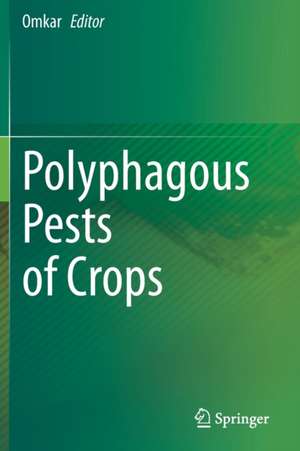Polyphagous Pests of Crops
Editat de Omkaren Limba Engleză Paperback – 6 ian 2022
| Toate formatele și edițiile | Preț | Express |
|---|---|---|
| Paperback (1) | 1555.34 lei 6-8 săpt. | |
| Springer Nature Singapore – 6 ian 2022 | 1555.34 lei 6-8 săpt. | |
| Hardback (1) | 1559.01 lei 3-5 săpt. | |
| Springer Nature Singapore – 5 ian 2021 | 1559.01 lei 3-5 săpt. |
Preț: 1555.34 lei
Preț vechi: 1896.76 lei
-18% Nou
Puncte Express: 2333
Preț estimativ în valută:
297.61€ • 324.29$ • 250.78£
297.61€ • 324.29$ • 250.78£
Carte tipărită la comandă
Livrare economică 23 aprilie-07 mai
Preluare comenzi: 021 569.72.76
Specificații
ISBN-13: 9789811580772
ISBN-10: 9811580774
Ilustrații: XII, 532 p. 143 illus., 86 illus. in color.
Dimensiuni: 155 x 235 mm
Greutate: 0.76 kg
Ediția:1st ed. 2021
Editura: Springer Nature Singapore
Colecția Springer
Locul publicării:Singapore, Singapore
ISBN-10: 9811580774
Ilustrații: XII, 532 p. 143 illus., 86 illus. in color.
Dimensiuni: 155 x 235 mm
Greutate: 0.76 kg
Ediția:1st ed. 2021
Editura: Springer Nature Singapore
Colecția Springer
Locul publicării:Singapore, Singapore
Cuprins
1 Locusts.- 2 Termites.- 3 Aphids.- 4 Whiteflies.- 5 Mealybugs.- 6 Scale Insects.- 7 Gram Pod Borer-(Helicoverpa armigera).- 8 Fall Armyworm-Spodoptera frugiperda.- 9 Thrips.- 10 Mites.- 11 Rodents.
Notă biografică
Prof. Omkar has been associated with the Department of Zoology, University of Lucknow as a faculty for the past 32 years and a former Head of Department. His specialization is Entomology in which he specifically concentrates on agricultural pests, dealing with the aphids and their natural enemy complex, specifically ladybird beetles. He is author and editor of several books, including Industrial Entomology, Pests and Their Management, and Sucking Pests of Crops, published by Springer Nature. He is an elected Fellow of The National Academy of Sciences, India (FNASc) besides many more.
Textul de pe ultima copertă
Polyphagous pests are primarily agricultural pests that feed on economically important agricultural and horticultural crops of wide taxonomic diversity across the globe. They cause immense damage across different crop varieties owing to their generalist and voracious food habits. The advent of mono-crop culture in a huge area and the massive use of pesticides post green revolution have massively increased pest outbreaks all over the world. The Middle Eastern countries, African continent and even the Indian subcontinent is increasingly facing resurgences of polyphagus pests. This book compiles an inclusive account of polyphagous pests. It covers locusts, termites, aphids, whiteflies, mealybugs, scale insects, gram pod borer, fall armyworm, thrips, mites and rodents. The book discusses mode of spread, enormity of losses caused, mechanism of action, and also means to reduce the crop losses. It brings together a unique perspective for researchers to learn effective pest management practices across all crops. This book is a reference guide to researchers and also useful for academicians and students of entomology.
Caracteristici
Is a focused and detailed compendium on global status of polyphagous pests Chapters supplemented with useful illustrations and pictures from the field Enables learning of effective pest management practices across all crops
